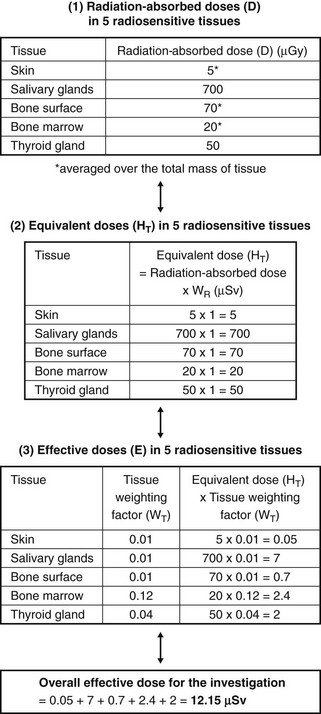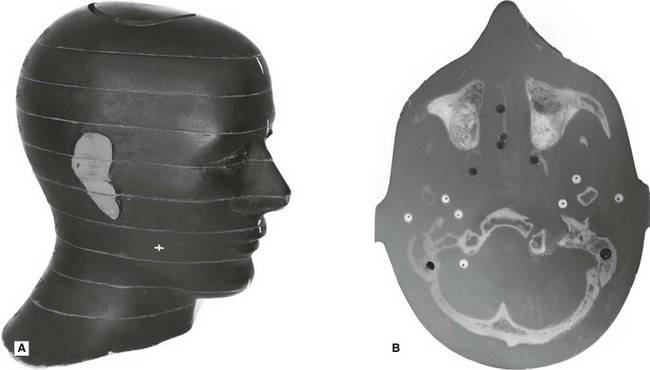Radiation dose, dosimetry and dose limitation
The more important terms in dosimetry include:
Equivalent dose (HT)
| X-rays, gamma rays and beta particles | WR = 1 |
| Fast neutrons (10 keV–100 keV) and protons | WR = 10 |
| Alpha particles | WR = 20 |
Equivalent dose (HT) = radiation-absorbed dose (D) × radiation weighting factor (WR) in a particular tissue

(For X-rays, the radiation weighting factor (WR) = 1, therefore the equivalent dose (HT) in a particular tissue, measured in Sieverts, is equal to the radiation-absorbed dose (D), measured in Grays.)
Effective dose (E)
Effective dose (E) = Σ Equivalent dose (HT) in each tissue × relevant tissue weighting factor (WT)

The tissue weighting factors recommended by the ICRP in 1990 and revised in 2007 are shown in Table 4.1.
Table 4.1
The tissue weighting factors (WT) recommended by the ICRP in 1990 and revised in 2007
| Tissue | 1990 WT | 2007 WT |
| Bone marrow | 0.12 | 0.12 |
| Breast | 0.05 | 0.12 |
| Colon | 0.12 | 0.12 |
| Lung | 0.12 | 0.12 |
| Stomach | 0.12 | 0.12 |
| Gonads | 0.20 | 0.08 |
| Bladder | 0.05 | 0.04 |
| Oesophagus | 0.05 | 0.05 |
| Liver | 0.05 | 0.04 |
| Thyroid | 0.05 | 0.04 |
| Bone surface | 0.01 | 0.01 |
| Brain | * | 0.01 |
| Kidneys | * | 0.01 |
| Salivary glands | — | 0.01 |
| Skin | 0.01 | 0.01 |
| Remainder tissues | 0.05* | 0.12† |
*Adrenals, brain, upper large intestine, small intestine, kidney, muscle, pancreas, spleen, thymus and uterus.
†Adrenals, extrathoracic airways, gallbladder, heart wall, kidney, lymphatic nodes, muscle, pancreas, oral mucosa, prostate, small intestine wall, spleen, thymus and uterus/cervix.
One way of calculating the effective dose is by using a tissue equivalent anthropomorphic phantom with dosimeters placed in the most radiosensitive regions, as shown in Fig. 4.1.
As individual doses are very small from any one examination, a number of radiographic exposures are repeatedly performed (e.g. ten times) using typical exposure factors (time, kV and mA), for that particular examination. The dosemeters are then ‘read’ to give a measurement of the radiation-absorbed dose (D) in the individual tissues. Using this data both the equivalent dose (HT) and the effective dose (E) may be calculated as shown in the simplified flow diagram shown in Fig. 4.2.

Stay updated, free dental videos. Join our Telegram channel

VIDEdental - Online dental courses




